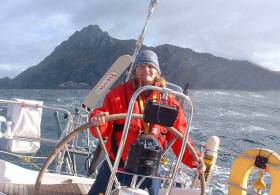Displaying items by tag: Irish Cruising
Irish Cruising Tops Weekend Agenda
Irish cruising under sail and power is being celebrated and developed this weekend. Last night’s AGM of the Irish Cruising Club in the National YC in Dun Laoghaire saw this 1929-founded organisation moving its many activities forward on all fronts while also distributing its annual awards – some of which date back more than 85 years – to honour a range of remarkable seagoing achievements.
And today, Irish Sailing’s Annual Cruising Conference - with the involvement of the Cruising Association of Ireland – is taking place in the larger venue of the Clayton Hotel in Leopardstown in south Dublin, a day-long information-packed gathering which is providing an unrivalled selection of expert topics and informed discussion groups in an atmosphere which evokes the special camaraderie of the sea. W M Nixon casts an eye over the current Irish cruising scene.
The interesting and attractive harbour town of Dungarvan in West Waterford would not be the first place that springs to mind when thinking of major sailing achievement. While it has a busy sailing club with a welcoming in-harbour pontoon for visitors and locals alike, much of the anchorage in the inner harbour dries, and the entrance channel from Dungarvan Bay requires careful negotiation.
Yet last night in Dun Laoghaire, the two top trophies in the Irish Cruising Club’s historic list both went to Dungarvan sailors.
The Faulkner Cup, which dates back to 1931, and the Strangford Cup, which was presented many years ago as an alternative to the Faulkner Cup when that season’s adjudicator couldn’t make up his mind when choosing between two superb cruises, will both be at home for the next year in Dungarvan, on display in that south coast town where the Comeragh Mountains and the Colligan River come to the sea at the broad east-facing bay in the lee of the Ring Peninsula.
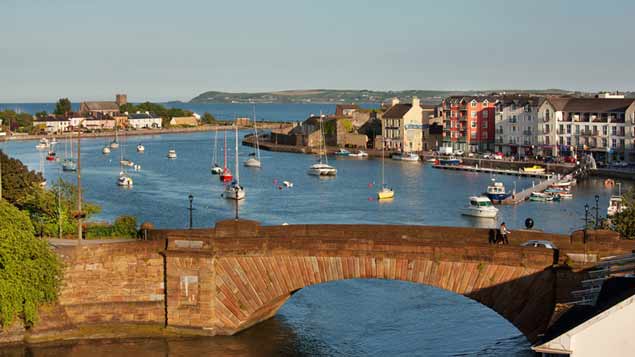 Dungarvan Harbour at high water. Despite the fact that much of the anchorage dries, the hospitality makes it a popular port of call
Dungarvan Harbour at high water. Despite the fact that much of the anchorage dries, the hospitality makes it a popular port of call
Not only that, but these remarkable award-winning sailors are sister and brother. And both their cruises in their respective boats were to the Arctic. To go north when your home port faces south, and has ancient trading links with France and most especially Spain, takes some extra determination.
Particularly so as Maire Breathnach, awarded the Faulkner Cup, and her brother Donal Walsh - who now holds the Strangford Cup - are the children of the late Gerry Walsh, a pioneer of Dungarvan sailing development, who was a junior crewmember on the only Dungarvan cruising boat of note in the 1950s, Reveille Farrell’s powerful 34ft 1936-built Bermudan cutter Susanna.
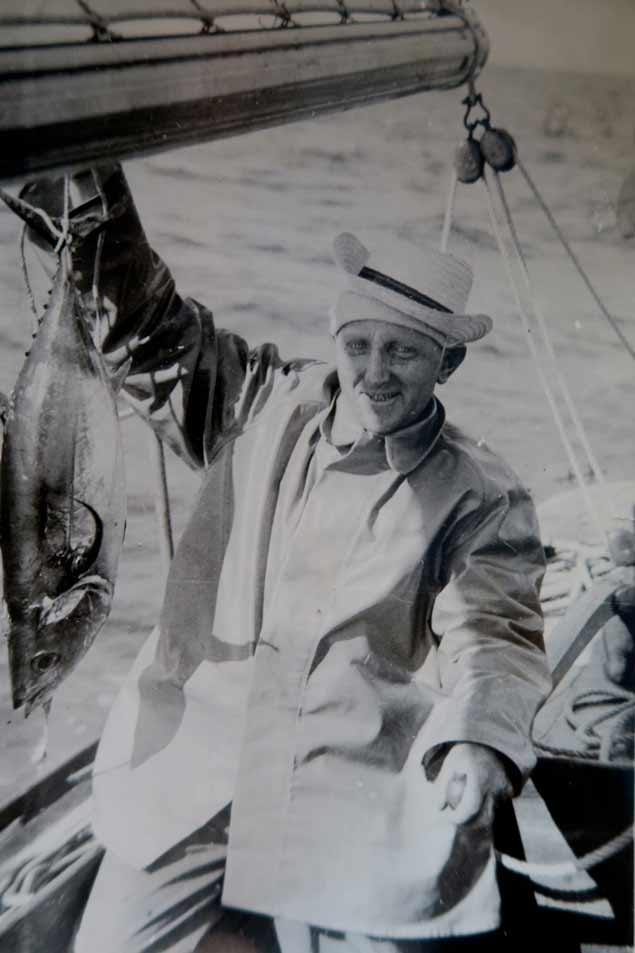 Gerry Walsh with some successful fishing aboard Susannah in 1957
Gerry Walsh with some successful fishing aboard Susannah in 1957
Susanna was later to acquire added distinction by winning the 1961 RORC Beaumaris to Cork Race under the ownership of National YC Commodore John McConnell. But in 1957 while still Dungarvan-owned, she cruised to Spain and back with the young Gerry Walsh on board, and family memories of that then-considerable venture have propelled the new Walsh generation on to stratospheric heights of seagoing achievement.
Donal built his reputation for some time with extensive cruising with the Moody 31 Lady Kate, while Maire – having started by cruising round Ireland single-handed in a Hurley 22 – then teamed up with Andrew Wilkes from the south of England, and they cruised round South America in the Swan 44 King of Hearts in 2004, an epic voyage which saw Maire being awarded the ICC’s Faulkner Cup for the first time.
Maire and Andrew married un due course, by which time they were sailing a very different boat – the steel-hulled gaff yawl Young Larry, a robust replica of an Edwardian cruising yacht with which they circumnavigated North America, Northwest Passage and all, and for this they were given the ICC’s supreme international accolade, the occasionally-allocated Fastnet Award, in 2014.
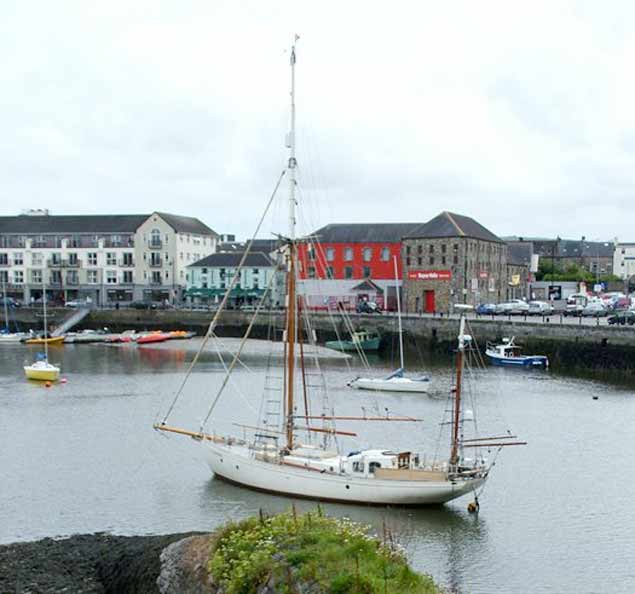 Young Larry over-wintering in the pool immediately below the bridge at Dungarvan
Young Larry over-wintering in the pool immediately below the bridge at Dungarvan
At home, Young Larry could just fit into the pool beneath the bridge at Dungarvan for a winter berth, but when they moved on to their current boat, the powerful 64ft steel gaff cutter Annabel J which is broadly a development of the Bristol Channel Pilot Cutter type, they found that her sheer size meant they had to use the Waterford City Marina – an hour or so up the road – as the winter berth.
Despite the massive nature of Annabel J’s gear and sails, there are times when this remarkable couple cruise quite extensively with just the two of them on board. And even when they are joined by sailing friends and relatives, Annabel J is never over-crewed.
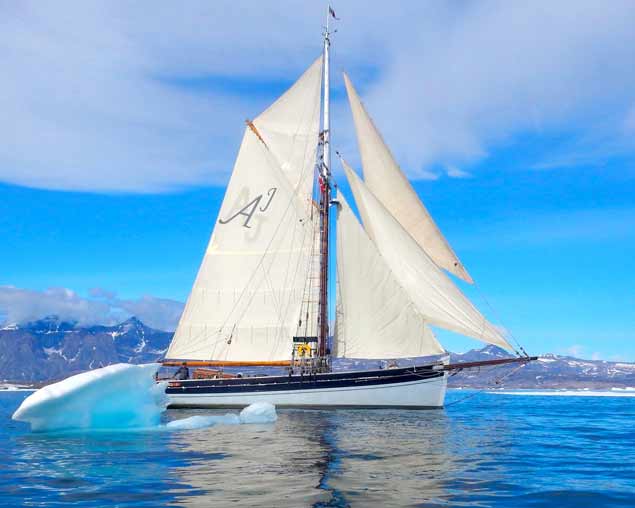 The 64ft Annabel J – quite a proposition for a crew of two, a real test of skill and experience.
The 64ft Annabel J – quite a proposition for a crew of two, a real test of skill and experience.
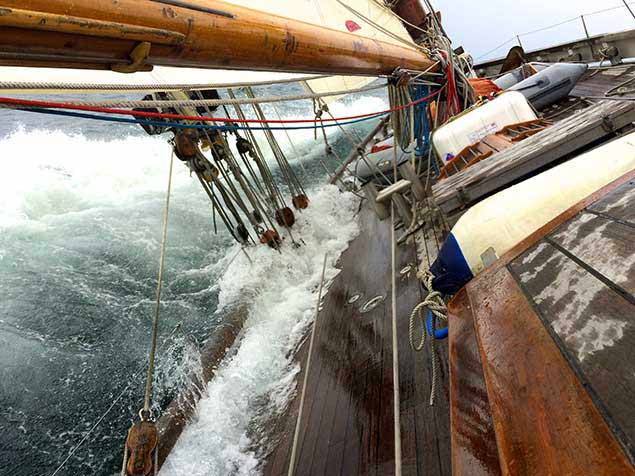 Traditional sail - Annabel J developing full power
Traditional sail - Annabel J developing full power
But she and her gallant sailors certainly do the business, for in 2017 they cruised north first to Iceland, and then on to Scoresby Sund in northeast Greenland before returning south westward of Iceland to complete a circumnavigation of that dramatic land, and on the way home in Westmanna – a place of historic Irish associations – they met up with brother Donal doing a “simple” round Iceland cruise with his alloy-built Ovni 385 Lady Belle which, thanks to its lifting keel, can comfortably berth where wished back home in Dungarvan.
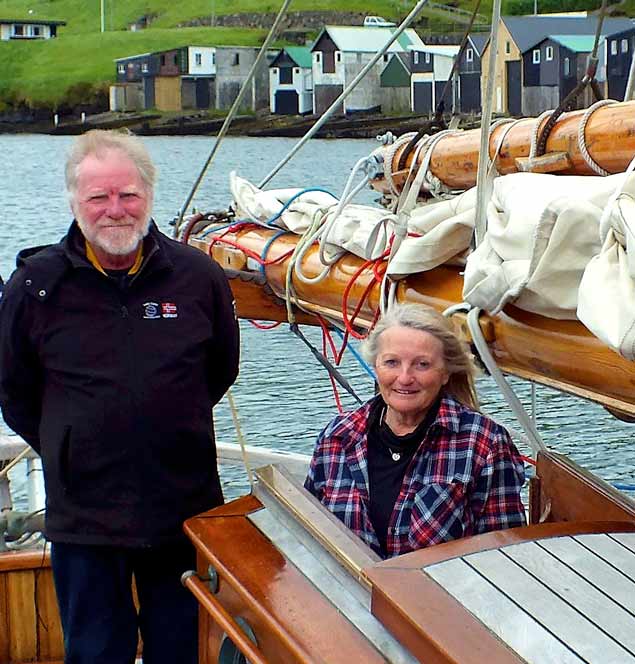 The seafaring children of Gerry Walsh – Donal and Maire met aboard Annabel J in Westmanna in Iceland
The seafaring children of Gerry Walsh – Donal and Maire met aboard Annabel J in Westmanna in Iceland
Both boats then returned to Dungarvan via the west coast of Ireland, so round Iceland and round Ireland circuits were part of the two projects, and on Lady Belle they even managed to take in a sighting of Rockall while homeward bound, a surprisingly small rock pinnacle which admittedly is more easily found with the latest SatNav gear.
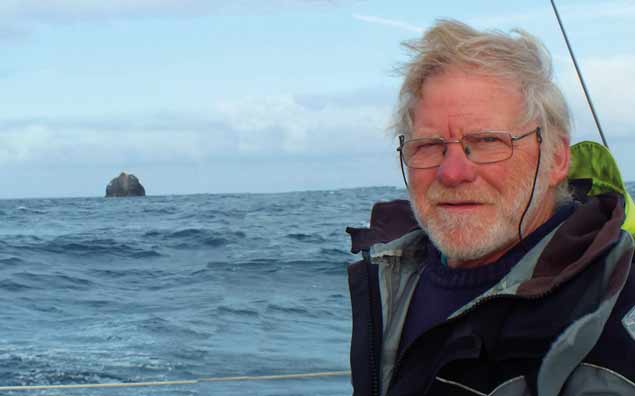 Donal Walsh takes his Ovni 385 Lady Belle past the elusive pinnacle of Rockall on passage from Iceland to the West Coast of Ireland
Donal Walsh takes his Ovni 385 Lady Belle past the elusive pinnacle of Rockall on passage from Iceland to the West Coast of Ireland
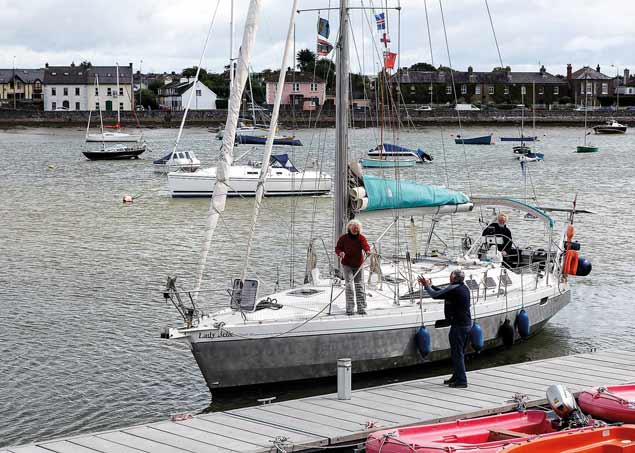 Lady Belle is welcomed back to the Pontoon in Dungarvan on her return from Iceland, Donal Walsh on the helm, and Clare Morrissey on the foredeck
Lady Belle is welcomed back to the Pontoon in Dungarvan on her return from Iceland, Donal Walsh on the helm, and Clare Morrissey on the foredeck
The season over, Maire’s work was only starting, as she had voluntarily taken on the Honorary Editorship of the Irish Cruising Club Annual, which her predecessor Ed Wheeler had raised to fresh heights of quality during his five years in the job. The new Edition, Maire’s first and covering the 2017 season, is a superb production, and it was comfortably with the membership at home and abroad in time for Christmas. But it was only last night in Dun Laoghaire that the annual awards could go fully public, as the annual distribution of prizes is now the concluding highlight of a very crowded and busy gathering.
It’s a gathering which reflects the truly all-Ireland nature of the club, which was one of its central aspirations when it was founded with an assembly of five cruising yachts at Glengarriff in July 1929. The current Commodore, Stanton Adair, cruises from Bangor on Belfast Lough. The Honorary Editor of the Journal, Maire Breathnath, is in Dungarvan. The Honorary Secretary, Alan Markey, sails from Howth. The Honorary Editor of the Irish Cruising Club Sailing Directions – which cover the entire coast in two continually-updated volumes – is Norman Kean, who cruises from Courtmacsherrry on the south Cork coast and is comprehensively supported in his efforts by Geraldine Hennigan. And the Honorary Awards Adjudicator for 2017 was Derek White, who cruises from Strangford Lough in a Fastnet 34 which was built in Limerick. So when we talk of an “Irish” Cruising Club, we really do mean it in the broadest sense.
And of course although Derek White chose to give the two main prizes to cruises to the High Arctic, there were many other extensive ventures to warmer places, although another noted high latitude project was the cruise to Svalbard by Michael and Ann Madsden of the NYC in Dun Laoghaire with their Starlight 35 Gabelle, for which they were awarded the Rockabill Trophy for Seamanship.
In complete contrast to all these icy wanderings, the ICC’s core organized event in 2017 was the Rally in the Rias of Northwest Spain in July. Organiser Peter Haden of Ballyvaughan in County Clare and his team thought they might get as many as thirty boats. But it proved so popular they had to cap the number at sixty.
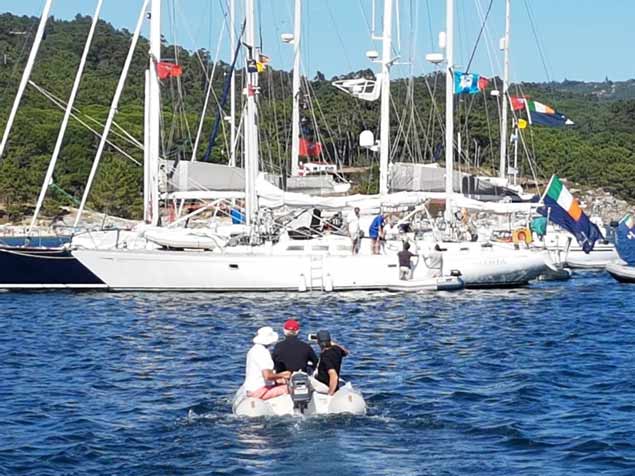 Fleet assembly during the ICC Rally in Galicia. In the foreground is Alex and Daria Blackwell’s Bowman 57 ketch Aleria from Clew Bay, and they’ll be speaking this afternoon about their ocean-sailing experiences at the Irish Sailing Cruising Conference. Photo Tansey Millerick
Fleet assembly during the ICC Rally in Galicia. In the foreground is Alex and Daria Blackwell’s Bowman 57 ketch Aleria from Clew Bay, and they’ll be speaking this afternoon about their ocean-sailing experiences at the Irish Sailing Cruising Conference. Photo Tansey Millerick
And an extraordinary selection they were too, coming from every direction, for the ICC now operates in an international way. So not surprisingly some of the cruises to get there were award-winning in themselves, a good example being by Portuguese-based John Duggan with his Castro 40 Hecuba, winner of the Strangford Cup in 2013. He’d a crew of all the talents with Daragh Nagle (winner in 2016 Faulkner Cup for his extensive Pacific islands cruise with his West Canada-based Moody 376 Chantey V) and that noted Dun Laoghaire sailor Ailbe Millerick.
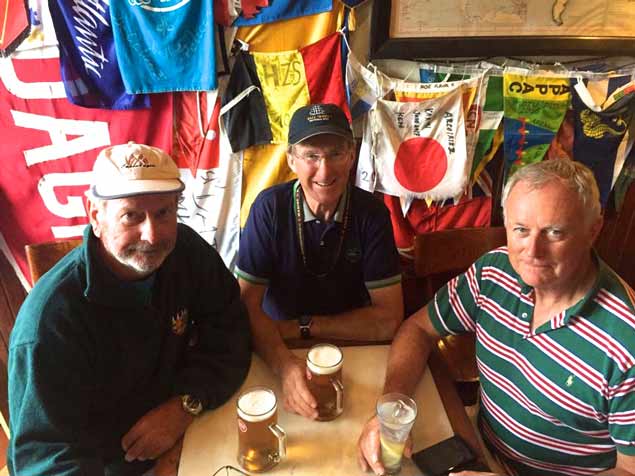 Seasoned ocean voyagers – Hecuba’s crew of Ailbe Millerick, Daragh Nagle and John Duggan in the legendary Peter’s Bar in Horta in the Azores.
Seasoned ocean voyagers – Hecuba’s crew of Ailbe Millerick, Daragh Nagle and John Duggan in the legendary Peter’s Bar in Horta in the Azores.
Ailbe hadn’t contributed to the ICC Annual before, so he was detailed off to tell how Hecuba got to the Spanish Rally from Cascais by first sailing out to the Azores, cruising those islands in some informative detail, and then shaping their course back to join the party. He tells the story so well that Hecuba and Ailbe Millerick are awarded the Perry Greer Bowl for the best first log, and as for the party in Spain, it was epic.
Most of us cannot even begin to guess at the level of background work which is needed to cater for the needs of 60 boats (many of them quite substantial craft) and their decidedly diverse crews as they make their way from one choice port or anchorage to another along one of Europe’s premier cruising grounds. So very deservedly Peter Haden was last night honoured with the Aran Islands Trophy of the ICC’s Western Committee for his quietly brilliant work in putting this marvellous happening together.
The accounts of its crowded events in the Annual are in total contrast to another log which Maire Breathnath has included in what she hopes will be a feature of future Annuals, a log from the archives. She has started it off in style with the story of her father and his shipmates from Dungarvan sailing the Susanna out to northwest Spain and back in 1957, and it perfectly captures the atmosphere of 61 years ago, when the world was very different, and boats were very different too, but the spirit of cruising was essentially the same.
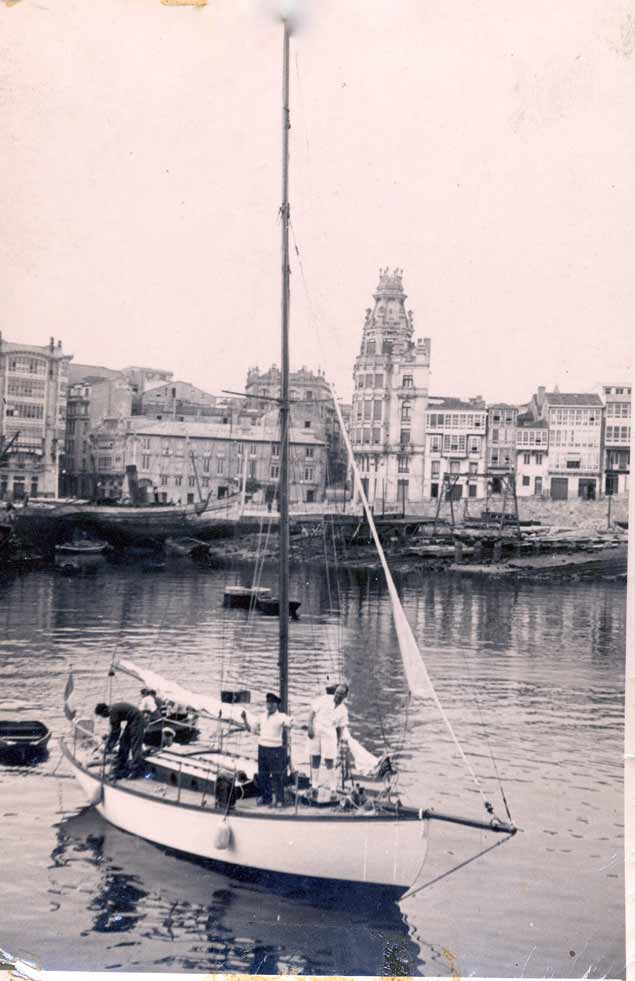 As it was then – Reveille Farrell’s 34ft Susanna from Dungarvan in northern Spain in 1957
As it was then – Reveille Farrell’s 34ft Susanna from Dungarvan in northern Spain in 1957
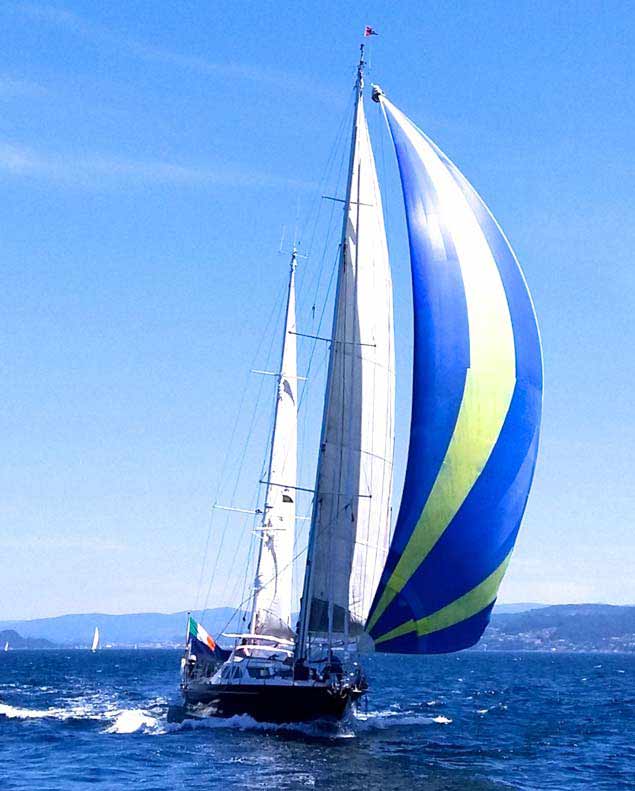 As it is now – Michal Holland’s 70ft ketch Celtic Spirit in in the ICC Rally, July 2017. Photo: Trish Phelan
As it is now – Michal Holland’s 70ft ketch Celtic Spirit in in the ICC Rally, July 2017. Photo: Trish Phelan
Of course, not all the logs in the 200-page Annual are about distant ventures, and with 13 awards for cruising, the Honorary Adjudicator is spoilt for choice. But one which continues to be very special for the ICC is the Round Ireland Cup, and for 2017 it goes to Alan Leonard of Strangford Lough, whose elegant circuit with the Starlight 35 Ariadne was gently made in detail by not actually declaring that he was on a clockwise round Ireland cruise until be noticed that his home port was nearer if he just kept gong the way he was, calling at many interesting places along the way.
At one of them, Rutland Harbour near Burtonport in Donegal in July, he met up with Charlie Kavanagh of Wicklow in his Sadler 34 Stravaiger, likewise on a leisurely round Ireland cruise, but this time anti-clockwise. Alan asked him when he hoped to get home. “October” said Charlie. Now that definitely is cruising.
Other definitions and aspects of cruising will be part of today’s busy agenda at the Irish Sailing Cruising Conference in the Clayton Hotel in Leopardstown in Dublin. There’s a comprehensive all-day programme, and the interaction between the various organisations in cruising is reflected by the fact that the speakers include the ICC’s Norman Kean from Courtmacsherry, together with another ICC couple, Alex and Daria Blackwell from Clew Bay, while a third speaker, Galway’s Aodhan FitzGerald who is Research Vessel Manager with the Marine Institute, is likewise ICC.
Norman Kean and Geraldine Hennigan’s devotion to furthering cruising knowledge was neatly indicated in 2017 when they located their 40-footer Coire Uisge in northwest Spain well in advance of the ICC Rally, as they felt the available sailing directions were inadequate for some of the more detailed channels. As a result all participants were presented with crisp new ICC-quality directions filled with local knowledge which enabled them to take some very interesting routes.
However, Norman’s two presentations this afternoon are on New Developments in Infrastructure, which will provide real inside track material, as he’s a fellow of the Royal Institute for Navigation, while his second talk will be a real cry from the heart, as he’ll be moderating an open discussion on obstructive Fishing Gear.
His boat Coire Uisge experience a total and expensive foul up with submerged lobster gear a couple of seasons ago, so we can expect a detailed and heartfelt Norman Kean exposition and proposals for improvement in classic style.
As for Alix and Daria Blackwell, they’re also leading figures in the Ocean Cruising Club, and their experience of rough ocean weather with their Bowman 57 Aleria and other craft is extensive and varied. But sometimes it’s far from blissful. In the rough Atlantic weather of July 2016, Alex sustained broken ribs while helping a friend deliver a substantial American yawl from the Azores to Ireland, so even home runs can sometimes prove to be distinctly other than a cakewalk.
Certainly by the time the conference closes by 5.0pm this evening, we can expect to have taken on board some real quality information on the current state of Irish cruising. The knowledge is undoubtedly there, and organizer Gail MacAllister of Irish Sailing has provided the means of tapping into it.


























